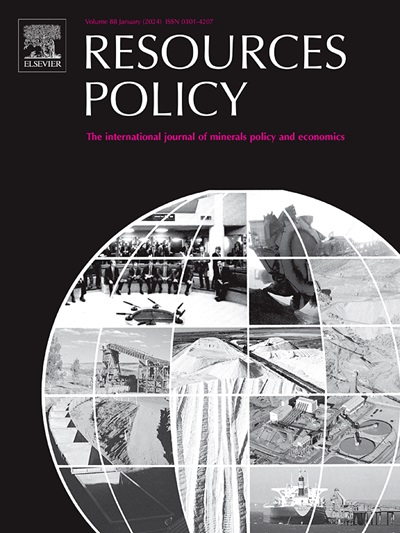上阿拉斯盆地(NE trkiye)地遗产元素资源评价方法——基于区间粗糙数(irn)的决策模型
IF 10.2
2区 经济学
0 ENVIRONMENTAL STUDIES
引用次数: 0
摘要
地质遗产元素是重要的地质资源,具有科学、教育和旅游用途,并有助于社会经济发展。为了可持续地保护这些资源,有效的政策是必要的。以新疆东北部上阿拉斯盆地为研究对象,采用多准则模型对地质遗产潜力进行评价。我们使用基于区间粗糙数(IRN)的组合模型SWARA(逐步权重评估比分析)和CoCoSo(组合折衷方案)作为本研究的方法。这种方法解决了在使用IRN评估地质遗产元素时可能出现的不确定性,促进了对其管理的群体决策。在研究中,将盆地内的地质遗迹划分为6类不同的地质遗迹类型。此外,还确定了它们在全球、国家、区域和地方各级的重要性。根据分析结果,G14(图兹卢卡彩虹山、天坑和鱼化石)、G8(阿尼遗址和岩石房屋)、G15 (Kağızman玄武岩柱)、G21 (Yazılıkaya岩画)和G2 (akakale岛和历史聚落)是五个最重要的地质遗址。在研究中,提出了建立法律依据、清单评估、建立地质公园和资源可持续利用等方面的建议,以制定有效的地质保护政策。此外,本文还讨论了地质遗产资源在可持续利用政策下的科学、教育和旅游潜力。通过整合多个专家意见,该方法有效地对地质遗址进行了评价和排序,证明了其在评估这些资源的重要性方面的有效性。总的来说,研究结果旨在促进地质遗产的有效管理和保护。本文章由计算机程序翻译,如有差异,请以英文原文为准。
An approach to assessment of geoheritage elements determined in the Upper Aras Basin (NE Türkiye) as resources: A decision-making model based on Interval Rough Numbers (IRNs)
Geoheritage elements are significant geological resources that provide scientific, educational, and touristic usage and contribute to socio-economic development. To protect these resources sustainably, effective policies are necessary. This study focuses on the Upper Aras Basin in northeast Türkiye, employing a multi-criteria model to assess geoheritage potential. We used the combined models SWARA (Stepwise Weight Assessment Ratio Analysis) and CoCoSo (Combined Compromise Solution), which are based on Interval Rough Numbers (IRN), for this study's methods. This approach addresses uncertainties that may arise in the assessment of geoheritage elements using IRN, facilitating group decision-making for their management. In the study, geosites in the basin were classified according to six different categories of geoheritage types. In addition, their importance was determined at the global, national, regional, and local levels. According to the analysis results, G14 (Tuzluca Rainbow Hills, Sinkholes and Ichnofossils), G8 (Ani Ruins and Rock Houses), G15 (Kağızman Basalt Columns), G21 (Yazılıkaya Rock Paintings) and G2 (Akçakale Island and Historical Settlement) ranked first as the five most important geosites. In the study, inferences regarding establishing legal basis and grounds, inventory evaluation, the creation of geoparks, and sustainable use of resources were formulated to create an effective geoconservation policy in Türkiye and the field. Additionally, it discusses the scientific, educational, and touristic potential of geoheritage resources under a sustainable use policy. By integrating multiple expert opinions, the methodology effectively evaluates and ranks geosites, demonstrating its usefulness in assessing the significance of these resources. Overall, the findings aim to promote effective management and conservation of geoheritage.
求助全文
通过发布文献求助,成功后即可免费获取论文全文。
去求助
来源期刊

Resources Policy
ENVIRONMENTAL STUDIES-
CiteScore
13.40
自引率
23.50%
发文量
602
审稿时长
69 days
期刊介绍:
Resources Policy is an international journal focused on the economics and policy aspects of mineral and fossil fuel extraction, production, and utilization. It targets individuals in academia, government, and industry. The journal seeks original research submissions analyzing public policy, economics, social science, geography, and finance in the fields of mining, non-fuel minerals, energy minerals, fossil fuels, and metals. Mineral economics topics covered include mineral market analysis, price analysis, project evaluation, mining and sustainable development, mineral resource rents, resource curse, mineral wealth and corruption, mineral taxation and regulation, strategic minerals and their supply, and the impact of mineral development on local communities and indigenous populations. The journal specifically excludes papers with agriculture, forestry, or fisheries as their primary focus.
 求助内容:
求助内容: 应助结果提醒方式:
应助结果提醒方式:


